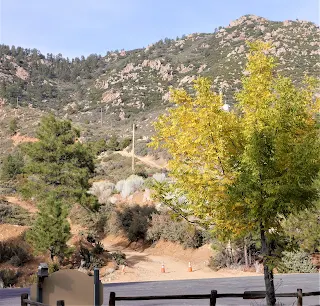According to the 2017 American Camper Report, nearly 41 million Americans went camping in
2016. That’s about fourteen percent of the population venturing out into nature,
having a great time – the other eighty-six percent didn’t have any good times
in 2016.
Anyone who has spent time enjoying the great outdoors
camping and staring up into the endless, inky dark night sky, knows what I am
writing about.
It’s awesome. Being out in nature, which is one of the
few pleasures we can indulge in at this time, is a wonderful experience. Fresh
air. Sunshine or moonshine (I mean looking up at the moon – not the stuff my
uncle used to make in his bathtub). Time with family and friends. Just an
overall quiet, good time.
And obviously, with the numbers reported by the American
Camper Report, a lot of people enjoy camping on their time off.
We do, and we did recently. Never having spent much
time in the Hualapai Mountains, just outside of the city of Kingman, Arizona –
we decided to do some rough camping.
Rough camping is defined as, not having room service, or any service at all for
creature comforts.
No calling down for a bottle of cold bubbly at ten in
the evening. No sheets turned down with a little mint waiting on the pillow. No
tiny bottles of shampoo, conditioner, and body lotion that seem to disappear at
check-out time.
Nope, simply a tent, sleeping bags, propane stove, foldable chairs, and your own personal toiletries. That’s rough camping, baby!
The mountain range in Mohave County, was named after
the Hualapai people who once lived there. Their name actually means, people of the tall pines – and there is an abundance of tall pines in these mountains.
If one wants to be an expert, the Hualapai Mountains
in the Mohave language is – Amat ‘Avii
Kahuwaaly (pronounced as it is spelled). These mountains have five tall
peaks which overlook the valley to the north of the city of Kingman.
“You know, the mountains are going to be chilly in the
evening,” Laureen noted, as I packed up our vehicle for the trek.
“I’ll build a fire.”
The look, only she can give, had me rethink that last
comment. “It’ll be a propane fire.”
In this year, 2020 – yeah, the one we’d like to forget
– has seen, according to the National Interagency Fire Center, over 47,277 wild
fires in ten states. Arizona alone, had seen more than 1,600 itself as of
November 1st.
With a quick call to the Mohave County Parks
Department, I spoke with a very informative person who informed me that no
fires of any type were allowed.
“So, my thought of a log fire the size of Kentucky is
a no-go,” I mentioned.
“That would be
a no.”
“Understood, how about a self-contained propane fire –
a small one?”
“That’s the only type allowed.”
We chit-chatted for a few minutes on how destructive
the forest fires have been in Arizona and the rest of the Southwest, as well as
the Northwest.
“People-made or nature produced?” I wanted to know.
I knew that in Northern California in August, a rare
dry lightning storm had caused over one thousand separate ground fires. I
hadn’t heard of any event of that magnitude in the state of Arizona, but was
curious.
“People caused.”
“Dumb people?” I asked.
“Who else would start fires when the forest is as dry
as it is?”
So, we packed up and drove off to the Hualapais for a
little rough camping. I did bring some little mints for the sleeping bags
though. That’s just the thoughtful kind of guy I am. I hope my wife appreciates
how lucky she is. Maybe one of my readers will write in and tell her how good
she’s got it. But I digress.
Hualapai Mountain Park, where the campground is
located, was actually constructed in the 1930s by the Civilian Conservation
Corps for the crews working on the Davis Dam, located near the town of Bullhead
City, Arizona.
It seemed that while the huge construction project was
under way, the workers felt a little overwhelmed, after sweltering in summer
temperatures that rivaled that of the surface of the sun.
“It’s really hot, boss.”
“Hey, it’s not that hot. Only my nose melted off
today, not my whole face. Now get back to work!”
So, the camp was built in the Hualapai Mountains,
where the summer average temperature is quite cool compared to where the dam
was being built, perhaps by thirty degrees. Here, the workers could cool off in
the mountain air, while listening to the soft breezes whistling through the
tall pines, instead of the constant cacophony of construction equipment.
It was a peaceful setting, and only about 45 miles
from the construction site. The park still has rock cabins from those days,
that visitors can rent by the day, the week, or the month. Right near the campsite
we stayed, there is a rock bridge over a creek built by those same workers who
constructed the Davis Dam.
History permeates the park. It is truly fascinating,
and shows the determination of those who built the dam, to make a nice,
comfortable, and soothing place to escape when not working in the heat of the
desert by the Colorado River.
We pitched camp around two in the afternoon and just
sat in a couple of chairs, enjoying the coolness of the mountains.
“This is lovely,” Laureen observed.
“I can’t hear you over the soft breeze through the
pine trees,” I replied.
At that moment, a Park Ranger’s truck pulled up in front of our campsite. Ranger Gino stepped out and advised us that no wood fires were allowed.
“Got the propane one ready,” I replied.
He was, as many people I meet along the byways – a
fount of knowledge. It was actually he, who informed us of how the campground
was created back in the 1930s. Ranger Gino was just a guy who loved his job and
stopped by each campsite explaining the do’s and don’ts that would be accepted
on his turf.
“You know, where you’re camped is the highway for our
elk.”
He then explained that all sorts of wildlife visit the
campground, depending on the season. There were the elk, he had mentioned, as
well as bear, mountain lions, deer, and other animals. “Just don’t feed them.”
“I only brought enough food for the two of us,” I
reassured Ranger Gino.
It seems, like many parks through-out the nation have
witnessed, visitors believe it’s kind to feed the wildlife, which then don’t
behave like wildlife. The animals become dependent on hand-outs from human
visitors, and when they don’t receive a freebie snack, they often become
demanding and aggressive.
“We’re all actually trying to retrain guests how to
interact with the wildlife. They are, after all, wild animals.”
Ranger Gino left and fifteen minutes later a
six-foot-tall elk walked by our camp. It stopped, looked at us and then moseyed
on her way into the forest to bed down for the evening.
Then it happened.
New campers came and started to set up camp two spots
down from us. I say, started to since within minutes of being there, one of the
campers decided that starting a huge bonfire was a great idea in a dry forest.
Ranger Gino, arrived like a superhero with radar, and
leaped from his truck.
“Oh, no – no – no,” he yelled, as the female fire
starter looked at him in surprise.
“You can’t have an open fire,” he stated. “There’re
signs everywhere forbidding it.”
“It’s not an open fire; it’s on the ground,” she responded.
Ranger Gino looked a bit perplexed at that statement.
I smiled at Laureen, “She is a dumb human, I think.”
She was, and our big ears picked up that she and her
friends were being booted from camping here for the remainder of the year.
Ranger Gino didn’t even issue a fine as he could have – gave them a break. What
a nice guy!
Other than that, the camping was wonderful and
peaceful – but one thing to remember is to always follow the rules when out in
the great outdoors.
And don’t be dumb. It’s embarrassing for the rest of
us who have to share this Earth.








No comments:
Post a Comment